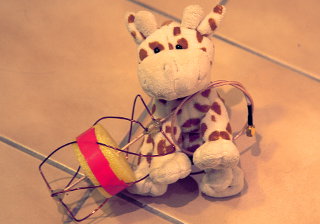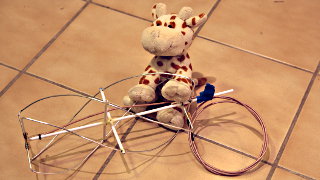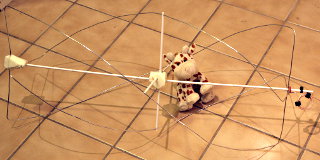
This QHA was for the GPS unit that flew onboard SATS's and Pollux's first hybrid rocket, the Haisunäätä. It is made of copper wire according to Michael Fletcher's instructions. A chip capacitor at the feedpoint keeps the antenna from shorting out GPSs that provide an operating voltage for active antennas. The cow is one of my regular helpers in antenna related matters. His name is Roope.

Haisunäätä's follower, Iso-Haisu carried onboard it a QHA for the 868 MHz sub-giga ISM frequency, used to transmit telemetry to the ground station. The receiver antenna was a helix beam with a custom-made LNA. This was a perfect combination for tracking the rocket, and the signal was strong until the rocket landed just beyond the horizon. This is simply a scaled-up version of the above GPS antenna, minus the feedpoint chip capacitor. A disc of closed-cell foam gives some support to the helices.

This lightweight antenna is made of 2 mm thick aluminum wire plus a couple of plastic support struts. It was meant to go onboard a high-altitude balloon for transmission of telemetry on the 70 cm amateur band. The polarization is LHCP, and it radiates downwards when the antenna is hung by its feedline. The construction is identical to the above two antennas, but this one was made of aluminum wire. AluSol solder was used to connect the aluminum wires onto a piece of veroboard (stripboard), where the feedline was also attached.
Instead of connecting the midpoints of the two loops to the coax shield, a choke balun was made to decouple the feedline. It consisted of several turns of coax tightly wound in the center of the antenna. I don't know if that actually worked or not...
In the end this antenna never flew, as we decided to use APRS on 2 m instead.

This is like the above antenna, just bigger. Also, the feedpoint was reconfigured to change the radiation direction. This way the radiation would be directed downward when the antenna is hung by its feedline (just like in the above 70 cm QHA), but the feedline does not pass through the antenna and can thus be shorter. Every gram of weight counts onboard a balloon! :) This antenna weighs only 75 g.
The coax passes several times through four Amidon FT50-43 ferrite beads. This appears to do a reasonable job of decoupling the feedline from the antenna.